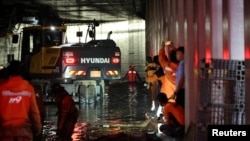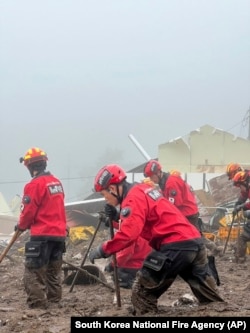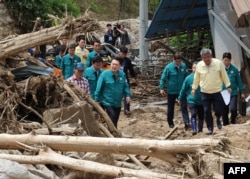South Korea has been inundated with weeks of on-and-off torrential rain that so far has killed at least 41 people, halted trains on concerns of weakened foundations, and left thousands picking up the pieces from storm damage, even as more rain is forecast.
Back from a Europe tour and chairing an emergency meeting Monday, President Yoon Suk Yeol instructed officials to designate special disaster zones and spare no effort in supporting regional relief and rebuilding efforts.
Yoon also criticized lax local governments, as inaction is increasingly being blamed for more than a dozen deaths inside a flooded tunnel in Cheongju city, North Chungcheong Province.
The underground tunnel was not closed to vehicle traffic even as flood warnings were in place, according to local media reporting. A flash flood resulted when a levee failed due to a heavy deluge, officials said. At least 14 bodies were recovered even as emergency crews were still draining the tunnel early Monday.
“Storm readiness must be planned with the thinking that the types of global warming scenarios [we’re seeing now] is the norm and not the exception,” Yoon urged. “We must completely overhaul the thinking that our hands are tied.”
Much of the storm damage so far has been in the mountainous central parts of South Korea, which was pounded with the most precipitation in a decade over the weekend.
Landslides claimed several lives, government data showed, as hundreds of roads were damaged or collapsed, tens of thousands of hectares of farmland were flooded, and more than half a million livestock were lost.
“I’ve run a flower shop for 20 years, and I’ve never seen anything like this,” one man told a domestic broadcaster, as he dealt with the shock of loss with more heavy rainfall ahead.
Dozens of world heritage sites – including the Gongsanseong Fortress in Gongju city – suffered damage after being flooded, the government said.
Unpredictable rainy season
This year’s monsoon is unlike any seen before, local experts note, pointing to the hit-or-miss weather system that poured intense amounts of precipitation as it shifted from place to place, leaving a trail of destruction in its path.
Thinking was mixed as to whether the source of the increasingly unpredictable rainy season was due to monsoon effects, El Nino effects, or other reasons.
The capital Seoul and surrounding areas, which is home to roughly half of the country’s population, this month has been seeing its weather rapidly turn from heavy downpour to sultry conditions and back.
Seoul officials have been sounding alarm after last year’s historic deluge of upwards of 120 millimeters of rain per hour had left vehicles abandoned in the flooded boulevards of Gangnam district and families living in basement "banjiha" housing units were gripped with fear when rushing waters made it difficult to escape.
This summer, the weather agency introduced a new level of “extreme downpour” in its text message warnings to those in the capital region, sent out when precipitation is forecast to exceed 50 millimeters per hour and more than 90 millimeters over a three-hour interval.
But this season's heaviest damage -- the highest in 12 years in terms of fatalities -- is being observed in the central band of the country on the back of sustained rainfall.
"Rainfall averages for the entire monsoon season have already been eclipsed," said meteorologist Ban Ki-seong. Korea's monsoon season typically runs through early August. "When you look at big cities with weather stations such as Gwangju and Busan [in the central and southern regions], precipitation has nearly doubled."
Elsewhere in Asia
North Korea was also seen preparing for heavy rains on Monday. State media KCNA said its premier Kim Tok Hun toured farms in the South Hwanghae and South Pyongan Provinces, as he called for a scientific management of crops and systems to minimize loss from abnormal weather.
Authorities in Seoul are also watching the path of Typhoon Talim, the season’s fourth, as it skirts neighboring Hong Kong. Trading in the financial hub was shuttered on Monday as its government imposed a T8 signal, the third highest in its five level warning system, which also closed schools and most government services. Talim is expected to be the first typhoon to hit mainland China this year, according to forecasters.










